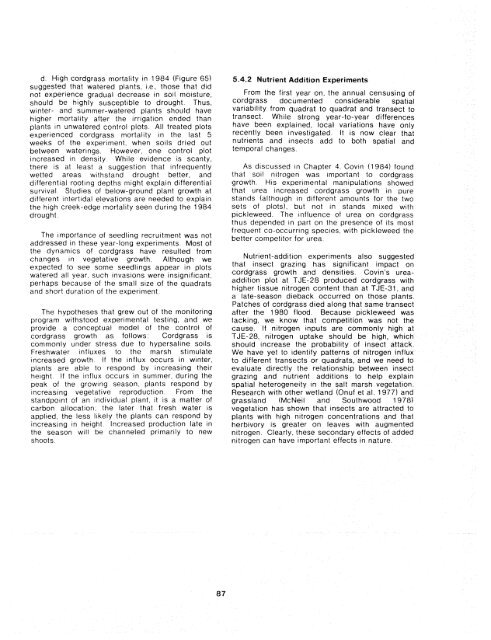The Ecology of Tijuana Estuary, California: An Estuarine Profile
The Ecology of Tijuana Estuary, California: An Estuarine Profile
The Ecology of Tijuana Estuary, California: An Estuarine Profile
You also want an ePaper? Increase the reach of your titles
YUMPU automatically turns print PDFs into web optimized ePapers that Google loves.
d High cordgrass mortalrty in 1984 (Figure 65)<br />
suggested that watered plants, I e, those that did<br />
not experience gradual decrease In soil morsture,<br />
should be highly susceptible to drought Thus.<br />
winter- and summer-watered plants should have<br />
hlgher mortality after the irrrgation ended than<br />
plants In unwatered control plots All treated plots<br />
expertenced cordgrass mortalrty In the last 5<br />
weeks <strong>of</strong> the expernment, when soils drred out<br />
between waterings However, one control plot<br />
increased In denstty While evrdence is scanty,<br />
there is a! least a suggestran that infrequently<br />
wetted areas wrthstand drought better, and<br />
differentral rooting depths might explarn differential<br />
survlval Studres <strong>of</strong> below-ground plant growth at<br />
different intertrdal elevatrons are needed to explarn<br />
the high creek-edge rnortalrty seen during the 1984<br />
drought<br />
<strong>The</strong> importance <strong>of</strong> seedlrng recrurtmerit was not<br />
addressed in these year-long experiments Most <strong>of</strong><br />
the dynamrcs <strong>of</strong> cordgrass have resulted from<br />
changes in vegetative growth Although we<br />
expected to see some seedlings appear In plots<br />
watered all year, such lnvastons were ~nsignificant,<br />
perhaps because <strong>of</strong> the srnall srze <strong>of</strong> the quadrats<br />
and short duration <strong>of</strong> the experrrnent<br />
<strong>The</strong> hypotheses that grew out <strong>of</strong> the monitoring<br />
program withstood experimental tasting, and we<br />
provide 8 conceptual model <strong>of</strong> the control <strong>of</strong><br />
cordgrass growth as fallows Cordgrass ts<br />
comtnonly under stress due to hypersaline soils<br />
Freshwater influxos to the marsh stimulate<br />
increased growth If the influx occurs in winter,<br />
plants are able to respond by increasing their<br />
height If the tnflux occurs in summer, during the<br />
peak <strong>of</strong> the growing season, plants respond by<br />
increasing vegetative reproductron From the<br />
standpoint <strong>of</strong> an rndrvrdual plant, it is a matter <strong>of</strong><br />
carbon allocation the later that fresh water ts<br />
applied, tho less likely the plants can respond by<br />
Increasing tn height increased productron late In<br />
the season wtl! be channeled primarily to new<br />
shoots<br />
5.4.2 Nutrient Addition Experiments<br />
From the flrst year on, the annual censuslng <strong>of</strong><br />
cordgrass documented considerable spatial<br />
variabll~ty from quadrat to quadrat and transect to<br />
transect While strong year-to-year differences<br />
have been explained, local var~atioris have only<br />
recently been investigated It is now clear that<br />
nutr~ents and insects add to both spatral and<br />
temporal changes<br />
As discussed 117 Chapter 4 Covrfi (1984) found<br />
that sol! nrtrogen was important to cordgrass<br />
growth His experimental manipulations showed<br />
that urea Increased cordgrass growth in pure<br />
stands (although in different amounts for the two<br />
sets <strong>of</strong> plots), but not rn stands mrxed with<br />
p~ckleweed <strong>The</strong> rnfluence <strong>of</strong> urea on cordgrass<br />
thus depended in part on the presence <strong>of</strong> its most<br />
frequent co-occurnng species, with ptckleweed the<br />
better competitor for urea<br />
Nutrient-additron expertments also suggested<br />
that rnsect grazing has signrficant impact on<br />
cordgrass growth and densrtres Covin's ureaadditron<br />
plot at TJE-28 produced cordgrass with<br />
higher tissue nitrogen content than at TJE-37, and<br />
a late-season dieback occurred on those plants<br />
Patches <strong>of</strong> cordgrass d~ed along that same transect<br />
after the 1980 flood Because prckteweed was<br />
lacktng, we know that compet~lion was not the<br />
cause If nrtrogen inputs are commonly high at<br />
TJE-28, nrtrogen uptake should be h~gh, which<br />
should increase the probabilrty <strong>of</strong> insect attack<br />
We have yet to rdentlfy patterns <strong>of</strong> nrtrogen influx<br />
to different transects or quadrats, and we need to<br />
evaluate directly the retattonship between rnsect<br />
grazing and nutilent additions to help explain<br />
spatial heterogenerty In the salt marsh vegetation<br />
Research w~th other wetland (Onuf et a!. 19773 and<br />
grassland (McNeil and Southwood 1978)<br />
vegetai~on has shown that insects are attracted to<br />
plants w~th high nrtrogen concentrations and that<br />
herbivory is greater on leaves with augmented<br />
nltrogen Clearly, these secondary effects <strong>of</strong> added<br />
nitrogen can have lmportanl effects In nature

















